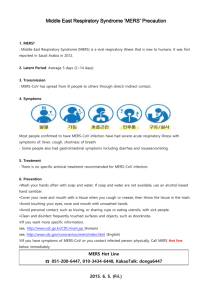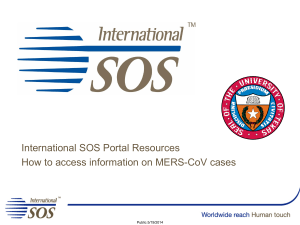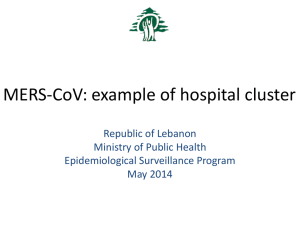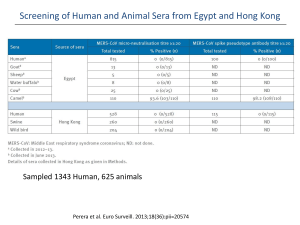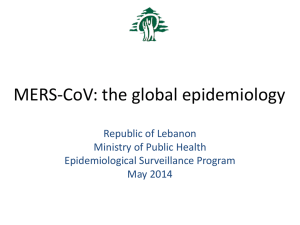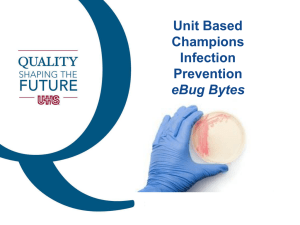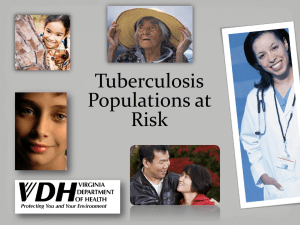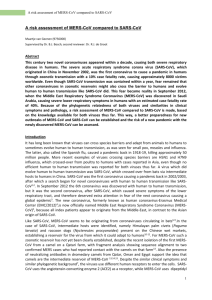5/6/2014 Key Points – Middle East Respiratory Syndrome
advertisement
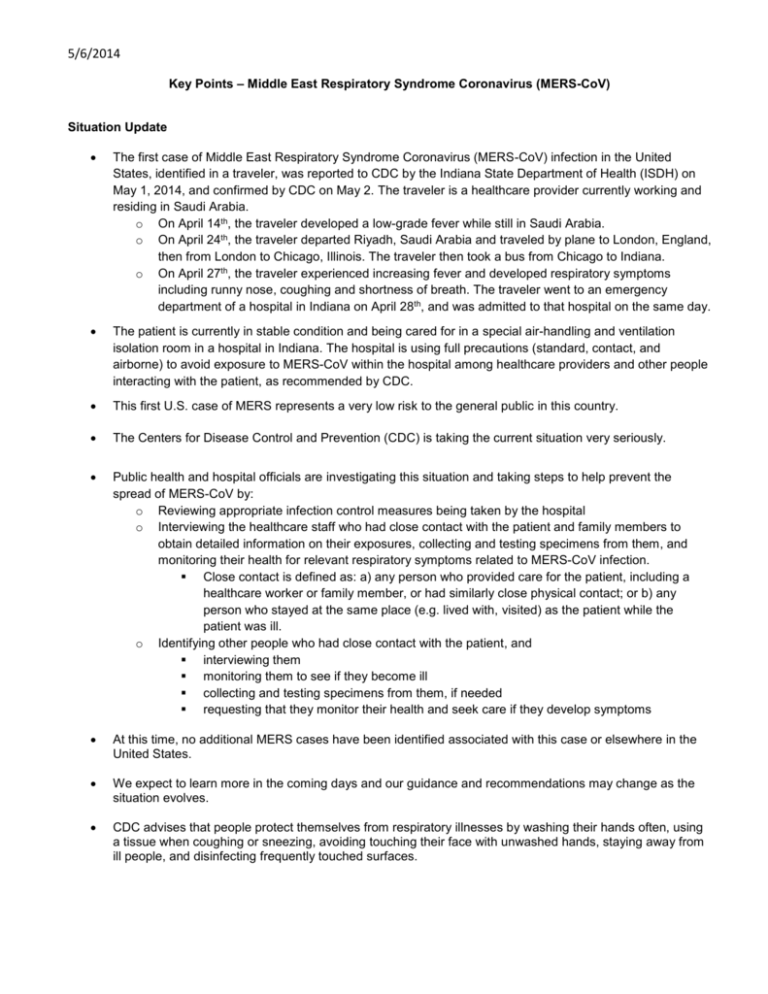
5/6/2014 Key Points – Middle East Respiratory Syndrome Coronavirus (MERS-CoV) Situation Update The first case of Middle East Respiratory Syndrome Coronavirus (MERS-CoV) infection in the United States, identified in a traveler, was reported to CDC by the Indiana State Department of Health (ISDH) on May 1, 2014, and confirmed by CDC on May 2. The traveler is a healthcare provider currently working and residing in Saudi Arabia. o On April 14th, the traveler developed a low-grade fever while still in Saudi Arabia. o On April 24th, the traveler departed Riyadh, Saudi Arabia and traveled by plane to London, England, then from London to Chicago, Illinois. The traveler then took a bus from Chicago to Indiana. o On April 27th, the traveler experienced increasing fever and developed respiratory symptoms including runny nose, coughing and shortness of breath. The traveler went to an emergency department of a hospital in Indiana on April 28th, and was admitted to that hospital on the same day. The patient is currently in stable condition and being cared for in a special air-handling and ventilation isolation room in a hospital in Indiana. The hospital is using full precautions (standard, contact, and airborne) to avoid exposure to MERS-CoV within the hospital among healthcare providers and other people interacting with the patient, as recommended by CDC. This first U.S. case of MERS represents a very low risk to the general public in this country. The Centers for Disease Control and Prevention (CDC) is taking the current situation very seriously. Public health and hospital officials are investigating this situation and taking steps to help prevent the spread of MERS-CoV by: o Reviewing appropriate infection control measures being taken by the hospital o Interviewing the healthcare staff who had close contact with the patient and family members to obtain detailed information on their exposures, collecting and testing specimens from them, and monitoring their health for relevant respiratory symptoms related to MERS-CoV infection. Close contact is defined as: a) any person who provided care for the patient, including a healthcare worker or family member, or had similarly close physical contact; or b) any person who stayed at the same place (e.g. lived with, visited) as the patient while the patient was ill. o Identifying other people who had close contact with the patient, and interviewing them monitoring them to see if they become ill collecting and testing specimens from them, if needed requesting that they monitor their health and seek care if they develop symptoms At this time, no additional MERS cases have been identified associated with this case or elsewhere in the United States. We expect to learn more in the coming days and our guidance and recommendations may change as the situation evolves. CDC advises that people protect themselves from respiratory illnesses by washing their hands often, using a tissue when coughing or sneezing, avoiding touching their face with unwashed hands, staying away from ill people, and disinfecting frequently touched surfaces. 5/6/2014 CDC recommends that healthcare providers evaluate patients for MERS-CoV infection using CDC guidance (see the section of this document entitled, “what healthcare professionals should do”). They should contact their state or local health department if they have questions. MERS Cases and Deaths (WHO) As of May 6, 2014, a total of 263 laboratory confirmed cases, including 93 deaths of MERS-CoV infection have been reported and confirmed by the World Health Organization (WHO). o Reported illness onsets were between April 2012 and April 2014. The majority (96%) of the cases resided in or recently traveled from Saudi Arabia, UAE, Qatar, Oman, Kuwait or Jordan. o A total of 244 cases, including 49 deaths, are pending WHO confirmation. o During a short amount of time starting in March 2014, there has been an increase in the number of cases reported from Saudi Arabia and UAE. The reason for this increase in cases is not yet known; public health investigations are ongoing. Cases among residents in countries in or near the Arabian Peninsula: o Saudi Arabia: 185 cases (68 deaths) o UAE: 48 cases (7 deaths) o Qatar: 9 cases (5 deaths) o Oman: 4 cases (4 deaths) o Jordan: 4 cases (3 deaths) o Kuwait: 3 cases (1 death) Cases identified in other countries: o UK: 3 cases (2 deaths) o France: 2 cases (1 death) o Tunisia: 3 cases (1 death) o Italy: 1 case (0 deaths) o Malaysia: 1 case (1 death) MERS and MERS-CoV Middle East Respiratory Syndrome (MERS) is the illness caused by Middle East Respiratory Syndrome Coronavirus (MERS-CoV). MERS-CoV is different from other coronaviruses that have been found to infect people. o MERS-CoV is not the same coronavirus that caused SARS in 2003. However, like SARS, MERSCoV has caused severe acute respiratory illness and pneumonia in many reported cases. We don’t know where the virus came from or exactly how it spreads. o Scientists are investigating clusters of MERS in countries in and near the Arabian Peninsula* to learn how the initially infected people (index cases) were exposed to the virus. o Studies have been done to test animals, including camels, for evidence of MERS-CoV infection. A recent study detected evidence of MERS-CoV (gene sequences) in three out of 14 camels on a farm, linked to two confirmed human infections from Qatar. MERS-CoV gene sequences have also been identified from dromedary camels in Saudi Arabia and Egypt, some associated with human cases. Other studies have shown that camels from several countries including in Egypt, Oman, and Spain had antibodies to MERS-CoV. This indicates that they had previous exposure to MERS-CoV or another closely related virus. Another study identified limited MERS-CoV gene sequence from a bat in Saudi Arabia. More information is needed to define the role that camels, bats, and other animals may play in possible transmission of MERS-CoV. In other countries affected by MERS: o Limited human-to-human spread has been reported, usually after close and prolonged contact, such as caring for or living with an infected person. 5/6/2014 o o There is no definitive evidence of sustained spreading in community settings. Clusters of human-to-human spread have been seen most frequently in healthcare workers caring for MERS patients. A cluster is defined as two or more persons with onset of symptoms within the same 14 days period, and who are associated with a specific setting such as a classroom, workplace, household, extended family, hospital, other residential institution, military barracks, or recreational camp. Symptoms Many people confirmed to have MERS-CoV infection have had severe acute respiratory illness. o Symptoms included fever, cough, and shortness of breath. o Many of them had pneumonia. o Some people also had gastrointestinal symptoms, including diarrhea. o Some have had kidney failure. o More than 30% of them died. Some people did not have any symptoms, or had only mild respiratory illness; they recovered. Risks Based on the information we have so far, people with pre-existing health conditions (comorbidities) or weakened immune systems may be more likely to become infected with, or have a severe case of, MERS. o Comorbidities from reported cases for which we have information have included diabetes, cancer, and chronic lung, heart, and kidney disease. Transmission In some cases, infected people have spread the virus to others through close contact, such as to people who were caring for or living with them. There is no definitive evidence of sustained spreading of MERSCoV in the community. Infected people have spread MERS-CoV to others in healthcare settings. This has happened in hospitals in Saudi Arabia, France, Jordan, UAE, and Qatar. o The largest reported MERS outbreak to date occurred April through May 2013 in eastern Saudi Arabia and involved 23 confirmed cases in four healthcare facilities. Additional hospital outbreaks are currently ongoing in Saudi Arabia and the United Arab Emirates. Most people who had close contact with people who had MERS-CoV infection did not get infected or ill. o This information is based on public health investigations of cases in Jordan, Saudi Arabia, the United Kingdom (UK), France, and Germany. o To better understand the risk for infection, we need additional information about the extent of exposures to infected people, frequency of community and household contacts, and contacts before and during illness. o We are working with our partners to carefully evaluate the first case of MERS in the U.S. Through this public health investigation, we hope to gain a better understanding of the virus, risk of transmission, and the spectrum of illness it causes. All reported cases have been linked to six countries in the Arabian Peninsula: Saudi Arabia, Qatar, Jordan, the United Arab Emirates (UAE), Oman, and Kuwait. o Most infected people either lived in the Arabian Peninsula or recently traveled from the Arabian Peninsula before they became ill. o A few people became infected with MERS-CoV after having close contact with an infected person who had recently traveled from the Arabian Peninsula. Public health agencies continue to investigate clusters of cases in several countries to better understand how MERS-CoV spreads from person to person. Vaccine and Treatment There is no vaccine to prevent MERS-CoV infection at the present time. 5/6/2014 There is no specific antiviral treatment recommended for MERS-CoV infection; medical care can help relieve symptoms. For severe cases, current treatment includes care to support vital organ functions. CDC has participated in an interagency working group led by the U.S. National Institutes of Health (NIH) to address the possibility of antiviral treatment, vaccine, and other possible treatments for MERS-CoV infection. o NIH has the lead in exploring possibilities for a MERS-CoV vaccine. o NIH has supported and conducted foundational work on potential SARS vaccines; this work may be helpful for developing a MERS-CoV vaccine. The FDA has not approved specific antiviral treatment for people with MERS-CoV infection. Also, CDC, NIH, FDA, and WHO do not currently have recommendations for specific antiviral treatment. What CDC is doing to prevent MERS in the United States CDC continues to closely monitor the MERS situation globally and work with the World Health Organization and other partners to understand the risks of this virus to the public’s health. We recognize the potential for MERS-CoV to spread further and cause more cases globally and in the United States. In preparation for this, we have o Enhanced surveillance and laboratory testing capacity in states to detect cases o Developed guidance and tools for health departments to conduct public health investigations o Provided recommendations for healthcare infection control and other measures to prevent disease spread o Provided guidance for flight crews, Emergency Medical Service (EMS) units at airports, and U.S. Customs and Border Protection (CPB) officers about reporting ill travelers to CDC o Disseminated up-to-date information to the general public, international travelers, and public health partners What the general public should do to protect themselves CDC routinely advises that people help protect themselves from respiratory illnesses by taking everyday preventive actions like washing their hands often; avoiding close contact with people who appear sick; avoiding touching the eyes, nose, and mouth with unwashed hands; and disinfecting frequently touched surfaces. People should monitor their health if they have had close contact with someone who has fever and symptoms of respiratory illness, such as cough or shortness of breath, after recent travel to a country in or near the Arabian Peninsula. What people should do if they develop symptoms People who develop a fever and cough or shortness of breath within 14 days after traveling from countries in or near the Arabian Peninsula should call a healthcare provider and mention their recent travel. While sick, stay home from work or school and delay future travel to reduce the possibility of spreading illness to others. What healthcare professionals should do Providers should be alert for and evaluate patients for MERS-CoV infection who 1) develop severe acute lower respiratory illness within 14 days after traveling from countries in or near the Arabian Peninsula, excluding those who only transited at airports in the region; or 2) are close contacts of a symptomatic recent traveler from this area who has fever and acute respiratory illness; or 3) are close contacts of a confirmed case. For these patients, testing for MERS-CoV and other respiratory pathogens can be done simultaneously. Positive results for another respiratory pathogen (e.g. H1N1 Influenza) should not necessarily preclude testing for MERS-CoV because co-infection can occur. Clusters of patients with severe acute respiratory illness (e.g. fever and pneumonia requiring hospitalization) without recognized links to cases of MERS-CoV or to travelers from countries in or near the Arabian Peninsula should be evaluated for common respiratory pathogens and reported to state and local 5/6/2014 health departments. If the illness remains unexplained, particularly if the cluster includes healthcare providers, testing for MERS-CoV should be considered, in consultation with state and local health departments. Healthcare professionals should immediately report to their state or local health department any person being evaluated for MERS-CoV infection as a patient under investigation (PUI). Additional information, including criteria for PUI are at http://www.cdc.gov/coronavirus/mers/interim-guidance.html. Healthcare providers should contact their state or local health department if they have any questions. Persons at highest risk of developing infection are those with close contact to a case, defined as any person who provided care for a patient, including a healthcare provider or family member not adhering to recommended infection control precautions (i.e., not wearing recommended personal protective equipment), or had similarly close physical contact; or any person who stayed at the same place (e.g. lived with, visited) as the patient while the patient was ill. Healthcare professionals should carefully monitor for the appearance of fever (T> 100F) or respiratory symptoms in any person who has had close contact with a confirmed case, probable case, or a PUI while the person was ill. If fever or respiratory symptoms develop within the first 14 days following the contact, the individual should be evaluated for MERS-CoV infection. Ill people who are being evaluated for MERS-CoV infection and do not require hospitalization for medical reasons may be cared for and isolated in their home. (Isolation is defined as the separation or restriction of activities of an ill person with a contagious disease from those who are well.). Providers should contact their state or local health department to determine whether home isolation, home quarantine or additional guidance is indicated since recommendations may be modified as more data becomes available. Additional information on home care and isolation guidance is available at http://www.cdc.gov/coronavirus/mers/hcp/home-care.html. Healthcare providers should adhere to recommended infection-control measures, including standard, contact, and airborne precautions, while managing symptomatic contacts and patients who are persons under investigation or who have probable or confirmed MERS-CoV infections. For CDC guidance on MERS-CoV infection control in healthcare settings, see Interim Infection Prevention and Control Recommendations for Hospitalized Patients with MERS-CoV at http://www.cdc.gov/coronavirus/mers/infection-prevention-control.html. For suspected MERS-CoV cases, healthcare providers should collect the following specimens for submission to CDC or the appropriate state public health laboratory: nasopharyngeal swab, oropharyngeal swab (which can be placed in the same tube of viral transport medium), sputum, serum, and stool/rectal swab. Recommended infection control precautions should be utilized when collecting specimens. Specimens can be sent using category B shipping containers. Providers should notify their state or local health departments if they suspect MERS-CoV infection in a person. State or local health departments should notify CDC if MERS-CoV infection in a person is suspected. Additional information is available at http://www.cdc.gov/coronavirus/mers/guidelines-clinical-specimens.html. Healthcare providers and facilities can take key actions now to enhance preparedness for MERS-CoV infection control. See: www.cdc.gov/coronavirus/mers/preparedness. Health departments should contact CDC’s Emergency Operation Center (770-488-7100) if they have questions. CDC recommendations and guidance for healthcare providers, health departments, and labs are available at www.cdc.gov/coronavirus/mers/interim-guidance. Additional or modified recommendations may be forthcoming as the investigation proceeds. Infection Control 5/6/2014 Any patient seeking care for symptoms consistent with MERS-CoV infection should be immediately placed in a private room with the door closed until an isolation room can be arranged. Evaluation and care of the patient should be performed using standard, contact, and airborne precautions while awaiting confirmation of diagnosis. Place a facemask on the patient whenever the patient is outside of the isolation room. Healthcare personnel should use eye protection in addition to disposable gowns, gloves, and respiratory protection when entering the isolation room. Patient care equipment, such as stethoscopes and blood pressure cuffs, should be dedicated to the isolation room and not moved from room to room. The patient care environment should be cleaned using an Environmental Protection Agency-registered hospital disinfectant, applied according to label instructions, with attention to toilets and frequently touched surfaces. People who have had unprotected contact, such as not wearing personal protective equipment, with a suspected MERS-CoV patient need to be monitored for symptoms, including fever, cough or shortness of breath. o Contacts are asked to seek medical care immediately if they develop symptoms and notify their local health department. Travel At this time, CDC does not recommend that anyone change their travel plans. CDC recommends that travelers stay informed by visiting www.cdc.gov/travel and following @CDCtravel for updates and the latest advice. o The travel notice for MERS-CoV has been upgraded to a level 2 alert. The travel notice advises people traveling to the Arabian Peninsula for health care work to follow CDC’s recommendations for infection control and other travelers to the Arabian Peninsula to take general steps to protect their health. CDC is continuing to do surveillance by working with our partners at U.S. ports of entry, including Customs and Border Protection, airlines, and Emergency Medical Service units at airports. o CDC has developed guidance to educate partners on the symptoms to watch out for and how to report illnesses to CDC’s quarantine station staff. CDC is reaching out to these partners to remind them about what to look for and report to CDC. o Together with partners at ports of entry, CDC staff are assessing ill travelers returning from affected areas who have been reported to CDC. The assessment helps determine whether the ill travelers are at risk for MERS-CoV infection and whether any additional public health actions are needed, such as a referral to a healthcare provider or public health department for evaluation and testing. CDC is advising people who develop fever and symptoms of respiratory illness, such as cough or shortness of breath, within 14 days after traveling from countries in or near the Arabian Peninsula to call a healthcare provider and mention their recent travel. CDC is also educating travelers to monitor their own health after returning from countries in or near the Arabian Peninsula. o Electronic monitors in airport international arrival areas direct people to information about MERSCoV. o Informational cards are provided to ill travelers, which recommend that they monitor their symptoms, call a doctor to make an appointment, and take steps to protect others from infection. 5/6/2014 CDC is conducting airline and bus contact investigations to identify and notify any travelers who may have been exposed to the U.S. imported case during that person’s travel. o CDC has gathered contact information from the airline and federal partners for passengers and crew who may have been exposed to this traveler during the flight to the United States. o CDC is working closely with the bus company to identify contact information and contact people who may have been exposed to the traveler on the bus. o CDC is conducting these contact investigations to Refer any contacts, such as fellow passengers or crew, who are identified with fever, or signs of respiratory illness, for medical evaluation, laboratory testing, and medical care, as needed. Provide information to exposed passengers and crew so they can recognize any symptoms of illness, then isolate themselves, if needed, and seek medical care. Determine whether MERS-CoV may have spread on the flight or bus and which passengers were at risk. CDC has shared contact information of passengers on the airplane with the U.S. imported case with state and local health departments in the areas where the travelers live or are staying. o A number of state health departments are helping CDC locate exposed passengers and determine whether they have symptoms and need to be tested and receive medical care for MERS-CoV infection. o The Public Health England is conducting a contact investigation for the flight from Saudi Arabia to England. Where people get more information about MERS CDC will post new information about MERS on their websites: o CDC website: www.cdc.gov/coronavirus/mers/index.html o Travelers’ Health: http://wwwnc.cdc.gov/travel/notices/alert/coronavirus-arabian-peninsula-uk Indiana State Department of Health: http://www.state.in.us/isdh/ WHO coronavirus infections website: www.who.int/csr/disease/coronavirus_infections/en/index.html
